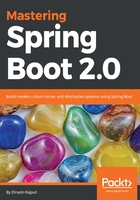
Preface
Mastering Spring Boot 2.0 is for all Java developers who want to learn Spring Boot and Spring Cloud as enterprise-distributed cloud-based applications. Therefore, enterprise Java and Spring developers will find this book particularly useful in helping them understand cloud-native design patterns using the microservices architecture used by Spring Boot 2.0 and Spring Cloud, how the microservices architecture solves the common design problems of the cloud-native infrastructure in distributed applications, and they will appreciate the examples presented in this book. Before reading this book, readers should have basic knowledge of the basics of Core Java, Spring Core Framework, and Spring Boot. You can read my other book, Spring 5 Design Patterns to learn more about Spring Framework.
Spring Boot 2.0 has been newly launched by Pivotal with the reactive programming and the cloud. Spring Boot 2.0 introduces many new features and enhancements we will discuss in this book. Mastering Spring Boot 2.0 is a mastering book that will give you in-depth insight into the Spring Boot and cloud microservices architecture.
The great part of today's Spring Boot is that many companies have already adopted it as a primary framework for the development of the enterprise applications, especially for the REST APIs using the microservices architecture. For Spring Boot, no external enterprise servers are needed to start working with them.
The goal of writing this book is to discuss the common designs used behind cloud-native applications and how they are implemented in the Spring Cloud module of the Spring Boot 2.0. Here, the author has also outlined some best practices that should be used during logging of the distributed design and development of the application.
The book contains 15 chapters, which cover everything from the development of microservices-based cloud applications to the deployment of microservices by either using virtual machines or containers such as Docker.
Mastering Spring Boot 2.0 is pided into four parts. The first part introduces you to the essentials of Spring Boot 2.0, Spring Boot CLI, and Spring Cloud. Part 2 steps behind the interservice communication in the microservices architecture using Rest Template, Spring Cloud Netflix Feign. Part 3 expands on that by explaining how to build an event-driven resilient system with Spring Cloud Stream and Kafka. This part also shows you how to monitor using Hystrix and Turbine. Finally, part 4 explains how to test and build APIs, and deploy to containers such as Docker, and also to clouds, such as AWS.